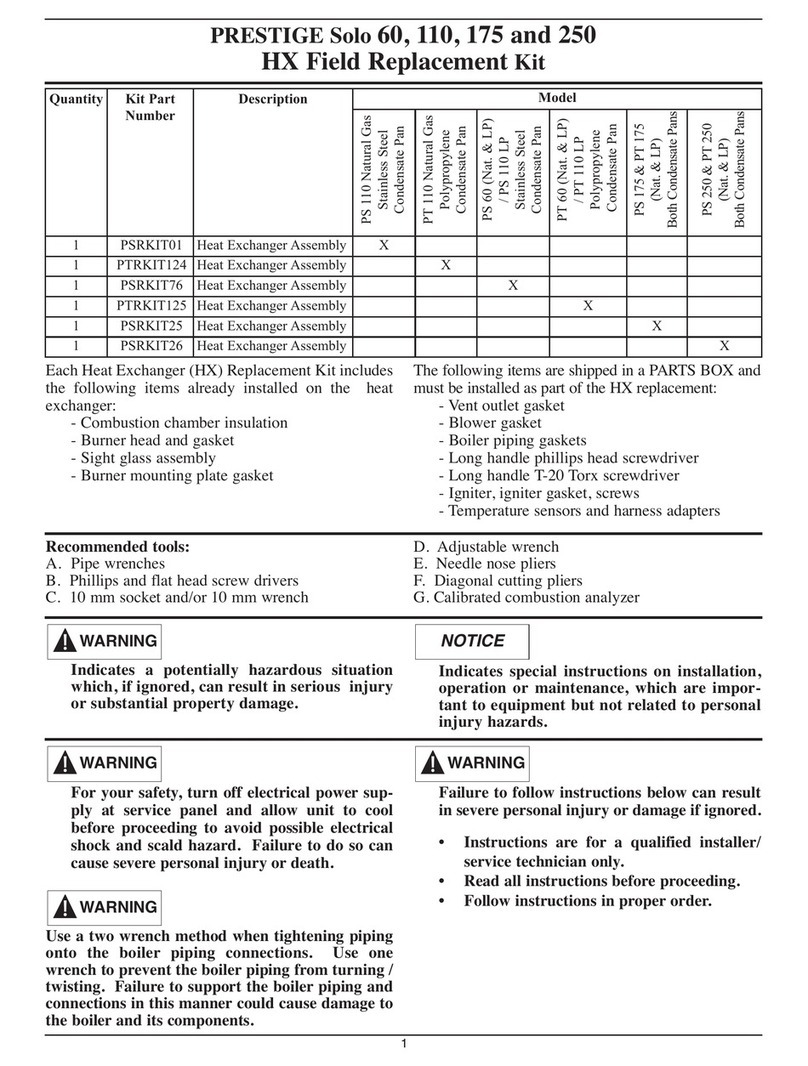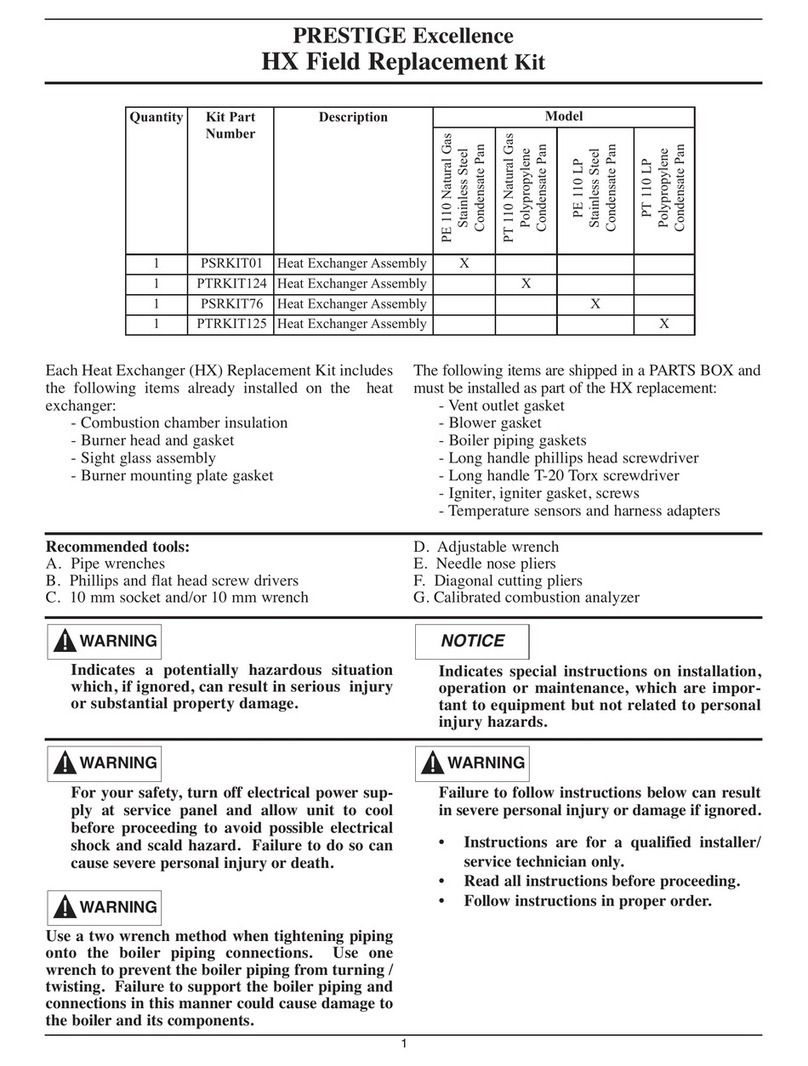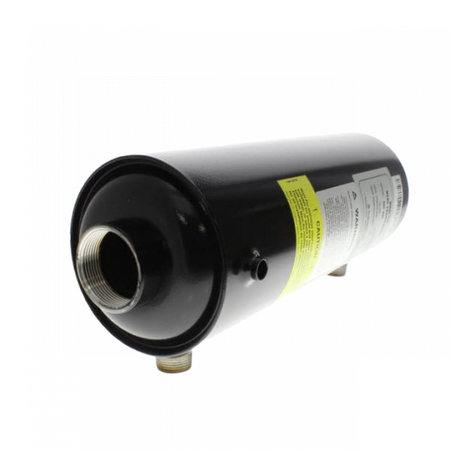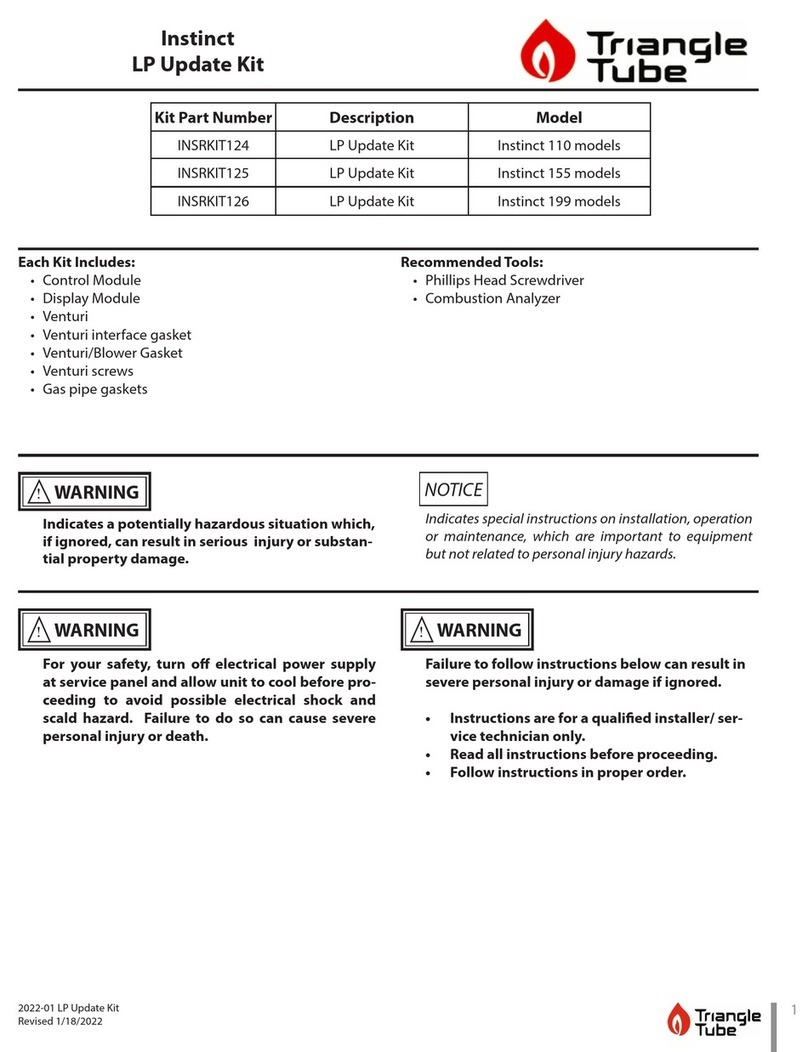
Prior to installation and operation, read the entire guide completely. Failure to follow
proper instructions can result in severe personal injury, death or substantial proper-
ty damage.
CODE COMPLIANCE & RESTRICTIONS
• All piping and installations must conform with the instructions in this guide and where
applicable:
-Local, state, provincial, and national codes.
•Where recommendations in this guide differ from local, state or national codes, the
local, state or national codes take precedence.
• The heat exchanger is a single wall exchanger and complies with National Standard
Plumbing Code provided:
-Boiler/primary water (including additives) is practically non-toxic, having toxicity
rating or Class of 1 as listed in Clinical Toxicology of Commercial Products, and
- Boiler/primary water pressure is limited to maximum 30psig by approved relief
valve.
Single wall heat exchangers are permitted under Uniform Plumbing Code - Paragraphs L3.2
and L3.3 if they satisfy all of the following requirements:
1. The heat transfer medium is potable water or contains only substances, which are
recognized as safe by the U.S. Food and Drug Administration.
2. The pressure of the heat transfer medium is maintained less than the normal min-
imum operating pressure of the potable water system.
3. The equipment is permanently labeled to indicate that only additives recognized
as safe by the FDA shall be used in the heat transfer medium.
Operating Restrictions
Max. Operating Pressure (“E” model): 150 psig
Max. Operating Pressure: 450 psig
Max. Operating Temperature: 365ºF
Min. Operating Temperature: (-)320ºF
Plate Material: AISI 316 Stainless Steel
Brazing Material: 99.9% Copper
WARNING
BRAZED PLATE HEAT EXCHANGERS
TTP SERIES INSTALLATION GUIDE
RADIANT AND SNOW MELT APPLICATIONS
• Typically the circuit with the highest temperature and/or pressure should be connected
to the left side connections indicated by the color label.
•The circuit flows should be piped in a counter-flow arrangement.
• Use antifreeze specifically intended for hydronic heating systems. Inhibited propylene
glycol is recommended.
Do not use automotive ethylene glycol or any undiluted or petroleum-based
antifreeze. This can cause damage to the exchanger and system components result-
ing in severe personal injury, death or substantial property damage.
STEAM TO WATER APPLICATIONS
• Ensure the braze plate heat exchanger is mounted vertically to allow gravity drainage
of the condensate.
•The installer should use “Good Steam Practices” which includes a steam trap below the
unit and vacuum breakers.
• The steam circuit must enter the heat exchanger’stop connection, with the condensate
leaving the exchanger through the bottom connection.
•Provide steam traps at critical points i.e. in front of the control valve, to prevent “pool-
ing” of condensate.
WARNING
1240 Forest Parkway, Suite 100
West Deptford, NJ 08066
Tel: (856) 228 8881 - Fax: (856) 228 3584
http://www.triangletube.com
2007-11 BP Inst. Guide 4/07
AVOID water hammering and other deformations caused by wet steam.
On low pressure steam systems or on applications with no-continuous processes,
place traps prior to the control valve and other critical points in the steam distribu-
tion system.
REFRIGERANT CONDENSER APPLICATIONS
• The heat exchanger must be mounted in the verti-
cal position to allow gravity drainage of the conden-
sate.
•The refrigerant gas must enter the heat exchanger
on the left side (indicated by the color label) using
the upper connection.
•The cooling water must enter the lower connection
of the exchanger and exit from the upper right con-
nection to maintain the counter-flow concept.
REFRIGERANT EVAPORATOR APPLICATIONS
•The heat exchanger must be mounted in the verti-
cal position.
•The refrigerant gas/liquid mixture must enter the
heat exchanger on the left side (indicated by the
color label) using the lower connection.
•The water must enter the upper right connection of
the exchanger and exit from the lower right con-
nection to maintain the counter-flow concept.
• The thermal expansion valve should be placed
close to the inlet connection of the heat exchanger.
The thermal expansion valve sensing bulb should
be placed on the refrigerant outlet approximately 12
to 24 inches from the heat exchanger.
• A pressure differential switch or flow switch must be installed to prevent possible
freeze-up due to loss of water flow.
NOTICE
• Water temperatures over 125ºFcan cause severe burns instantly or death from scalds.
• Feel water before bathing.
• Consumer Product Safety Commission and some states recommend temperature
settings of 130ºFor less. Setting thermostat higher than 130ºFwill increase the risk
of scald injury and cause personal injury or death.
• Water heated to a temperature suitable for clothes washing, dish washing and other
sanitizing needs will scald and cause permanent injury.
• Children and elderly, infirm, or physically handicapped persons are more likely to be
injured by hot water. Never leave them unattended in or near a bathtub. If anyone
using hot water in the building fits this description, or if state laws or local codes require
certain water temperature at hot water faucets, take special precautions:
- Install an automatic mixing valve at the exchanger or at each hot water faucet,
bath and shower.
- Use the lowest practical temperature setting.
- Check water temperature after any adjustments.
DANGER HOT WATER CAN SCALD!
F2
Water
Outlet
F4
Water
Inlet
Liquid
Outlet
F1 Gas
Inlet
F3
Fig. 3
F2
Water
Inlet
F4
Water
Outlet
Liquid
Inlet
F1 Gas
Outlet
F3
Fig. 4

























